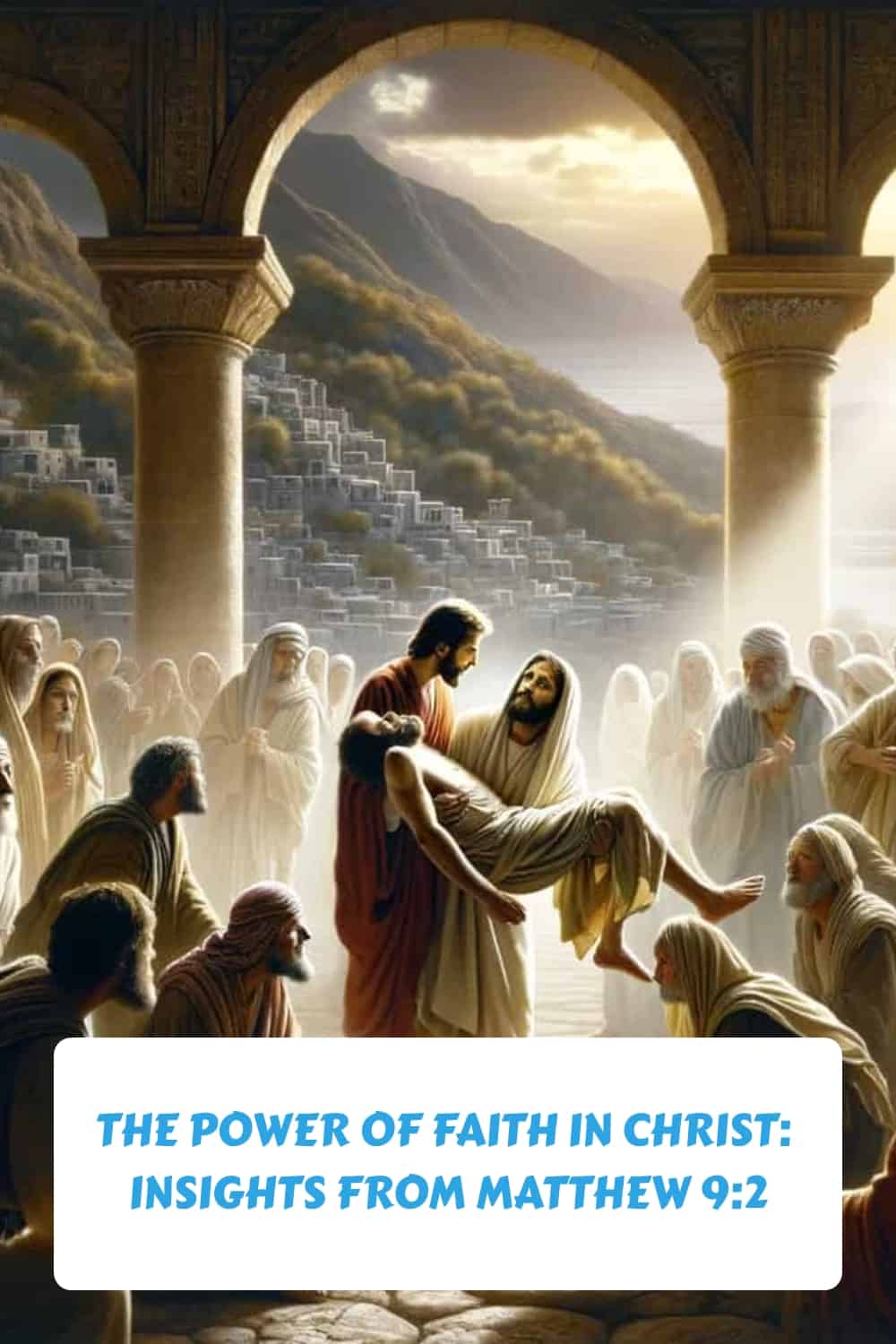Table of Contents
In the heart of Christian belief lies a profound concept: faith. More than just a word, faith forms the foundation of a Christian’s relationship with God. It’s a powerful blend of trust, belief, and conviction that shapes our understanding of the divine and our place in God’s plan.
“Jesus Seeing Their Faith”: A Testament to Belief
When we delve into the story of Jesus in Matthew 9:2, we encounter a pivotal moment that exemplifies the power of faith. Here, faith is not just a passive state of mind; it’s an active, dynamic force.
This narrative isn’t just about a miraculous healing; it’s a profound illustration of how Jesus recognizes and responds to the deep, genuine faith of individuals.
Faith: A Multidimensional Concept
Faith in Christianity is multidimensional. It encompasses:
- Belief in the unseen and trust in God’s promises.
- Devotion and unwavering commitment to God’s teachings.
- Confidence in God’s love and assurance in His plan.
- Reliance on God’s wisdom and hope in His providence.
These elements combine to form a steadfast, abiding faith that is central to the Christian experience.
The Impact of Faith on Individual Lives
The story in Matthew 9:2 is a testament to the transformative power of faith. It’s not just about believing in miracles; it’s about understanding the depth of one’s relationship with Jesus. It’s a story that encourages Christians to remain resolute and fervent in their faith, especially in challenging times.
In this article, we will explore the nuances of this story, seeking to understand how Jesus’ recognition of faith in Matthew 9:2 speaks to us today, and how it can inspire us to cultivate a stronger, more vibrant faith in our own lives.
Biblical Instances Demonstrating Faith

Faith in Action: Bringing the Sick to Jesus
Throughout the Gospels, we see numerous instances where faith in Jesus is vividly demonstrated. Notably, in Matthew 4:24 and 8:16, we find powerful examples of this faith in action.
Matthew 4:24 – A Testament to Trust
- Context: News of Jesus’ teachings and miracles spread throughout Syria.
- Action: People brought all those suffering from various diseases and torments, including those possessed by devils and those paralyzed.
- Reflection of Faith: This shows a collective trust and reliance on Jesus’ healing power. People’s willingness to bring the afflicted to Him reflects a deep conviction in His divine ability.
Matthew 8:16 – An Evening of Miracles
- Context: As evening came, many demon-possessed were brought to Jesus.
- Action: Jesus cast out the spirits with a word and healed all the sick.
- Demonstration of Faith: The act of bringing the demon-possessed to Jesus signifies a strong belief in His authority over evil and illness. It’s a clear manifestation of confidence in His power.
Other Scriptural Instances
- Mark 1:32: Similar to Matthew 8:16, emphasizing the community’s hope and devotion to Jesus’ healing.
- Luke 5:18-19: The story of the paralytic being lowered through the roof, showing unwavering faith and innovation in the face of obstacles.
Faith Demonstrated
| Scripture | Ailment | Faith Demonstrated |
|---|---|---|
| Matt 4:24 | Various diseases, possession | Bringing the sick to Jesus |
| Matt 8:16 | Demon-possession, illness | Seeking Jesus’ healing word |
| Mark 1:32 | Diseases, demon-possession | Crowding to Jesus for healing |
| Luke 5:18-19 | Paralysis | Overcoming barriers to reach Jesus |
Faith Beyond Healing: A Deeper Trust
- These actions go beyond seeking physical healing. They represent a reliance on Jesus for spiritual wholeness.
- The faith shown here is resolute and fervent, demonstrating a genuine trust in Jesus’ ability to transform lives.
In sum, these biblical instances not only showcase faith in Jesus’ ability to heal but also illustrate a deeper, more profound assurance and loyalty to Him. They teach us about the strength and impact of faith in our lives.
The Event of Matthew 9:2 in Detail

The Miraculous Moment: A Paralytic Brought to Jesus
In Matthew 9:2, we witness a remarkable event that vividly illustrates the power and significance of faith in Jesus Christ. This event unfolds as follows:
- The Setting: Jesus is in a house, surrounded by a crowd.
- The Action: A group of people bring a man paralyzed to Jesus. Their determination is evident as they overcome the obstacle of the crowd.
- The Climax: Jesus sees their faith. He doesn’t just observe their action; He recognizes the trust, devotion, and confidence they have in Him.
Jesus’ Acknowledgment of Their Faith
Jesus’ response to this faith is profound. He doesn’t merely heal the man physically; He addresses the man spiritually, forgiving his sins. This act has several layers of significance:
- Healing Beyond the Physical: Jesus’ reaction shows that He values faith over physical condition. His focus on forgiving sins highlights the deeper spiritual healing He offers.
- Faith as a Key to Divine Action: This moment underscores that faith is not just about belief; it’s an active, dynamic force that elicits a response from Jesus.
- A Model for Believers: This event serves as a powerful example for Christians. It illustrates how deep, genuine faith can lead to both spiritual and physical healing.
Implications for Christians Today
- Faith in Action: The actions of those bringing the paralytic to Jesus remind us that faith often requires action. It’s not passive; it’s engaging and proactive.
- Trust in Jesus: This event reinforces the belief that Jesus recognizes and responds to our faith. It encourages Christians to maintain a steadfast, resolute faith in Him.
- The Power of Collective Faith: The communal aspect of this event highlights the importance of supporting and uplifting each other in faith.
The event in Matthew 9:2 is more than a story of physical healing. It’s a profound demonstration of how faith in Jesus can lead to transformative experiences, both physically and spiritually. It invites believers to reflect on the depth and quality of their faith and to act upon it with confidence and conviction.
The Role of Faith in Healing and Forgiveness

Interweaving Faith with Healing and Forgiveness
The event in Matthew 9:2 is not just a narrative about physical healing; it’s a profound testament to the intertwined relationship between faith, healing, and forgiveness in Christian doctrine.
Healing Through Faith
- Physical Healing: The physical healing of the paralytic demonstrates Jesus’ power. It’s a visible, tangible result of faith.
- Spiritual Healing: More importantly, it signifies spiritual healing. Jesus first forgives the man’s sins, addressing the spiritual before the physical. This act reveals that true healing in Christianity encompasses both the body and the soul.
Faith as a Channel for Forgiveness
- Direct Connection: In this event, Jesus directly links faith to forgiveness. The faith of the individuals not only leads to physical healing but also opens the door to spiritual forgiveness.
- Divine Mercy: This connection highlights the concept of God’s mercy. Faith acts as a bridge that allows believers to receive God’s grace.
The Dynamics of Faith and Divine Grace
- Active Faith: The story shows that faith is active and dynamic. It’s not a passive belief but a force that prompts divine action.
- Grace and Mercy: It also underscores the Christian belief that grace and mercy are freely given by God but are often accessed through faith. Faith is the key that unlocks the fullness of God’s love and compassion.
The Broader Implications for Believers
- Holistic Approach to Faith: Christians are encouraged to view faith as encompassing both belief and action. It’s a faith that heals not just physically but spiritually.
- Living a Faith-Filled Life: This story inspires believers to live a life that reflects this deep and abiding faith, trusting in Jesus for both physical needs and spiritual nourishment.
The event in Matthew 9:2 serves as a powerful reminder of the role of faith in connecting believers with the healing power and forgiving grace of Jesus Christ.
It’s a call to cultivate a faith that is not only strong and unwavering but also deeply intertwined with the very essence of Christian life—receiving and recognizing God’s grace and mercy.
Lessons from the Roof Incident (Mark 2:4, Luke 5:19)

Unwavering Faith in Action
The ‘Roof Incident’, as narrated in Mark 2:4 and Luke 5:19, offers profound lessons on the nature of unwavering faith and its implications in the Christian walk.
The Incident: A Display of Determination
- The Challenge: Jesus was teaching in a crowded house, making it impossible for a group carrying a paralytic to reach Him.
- The Action: Undeterred, they climbed onto the roof, removed part of it, and lowered the paralytic down to where Jesus was.
- The Significance: This act was a radical demonstration of faith and perseverance. It wasn’t just about overcoming a physical barrier; it was about the relentless pursuit to reach Jesus, reflecting a resolute and fervent belief in His power to heal.
Implications of Their Actions
- Active Faith: This story exemplifies that faith in Jesus is not passive. It’s dynamic and sometimes requires bold, unconventional actions.
- Community Support: It also underscores the importance of community in the Christian faith. The friends of the paralytic played a crucial role in facilitating his healing, demonstrating the power of collective faith and support.
Jesus’ Response: Affirming Faith
- Acknowledgment of Faith: Jesus didn’t just see their physical effort; He recognized their faith. This acknowledgment is significant as it shows that Jesus values the faith behind actions.
- Healing and Forgiveness: In response, Jesus heals the paralytic and forgives his sins, signifying that faith leads to both spiritual and physical restoration.
Modern-Day Reflection
- Emulating Their Faith: This incident challenges modern-day believers to reflect on their level of faith. Are we willing to go the extra mile, to do whatever it takes, to reach Jesus?
- Implications for Christian Living: It invites Christians to be proactive in their faith, to support each other, and to be innovative in overcoming obstacles that prevent them from connecting with Jesus.
The Roof Incident is not just a miraculous story of healing; it’s a vivid illustration of the depth and determination of faith required in following Jesus. It teaches Christians to be active in their faith, to support one another, and to never let obstacles prevent them from seeking Jesus’ presence and power in their lives.
Faith as Seen by Jesus and the Apostles

Perceiving Faith: A Divine Insight
In the Christian narrative, Jesus’ ability to perceive faith is a recurring theme, as highlighted in John 2:25 and Acts 14:9. This ability extends to his Apostles, demonstrating a profound spiritual insight that is central to the Christian faith.
Jesus’ Insight into the Human Heart
- John 2:25: This verse underscores Jesus’ unique ability to understand the human heart without anyone needing to tell Him. It implies that Jesus could see the faith, or lack thereof, in individuals.
- Spiritual Perception: This ability signifies more than just understanding; it’s a divine insight into the true nature of a person’s faith and intentions.
The Apostle Paul and the Perception of Faith
- Acts 14:9: Here, Paul looks intently at a man and perceives that he has faith to be healed. This moment is significant as it shows the Apostles also possessed an understanding of people’s faith.
- Continuation of Jesus’ Ministry: This perception in the Apostles suggests a continuation of Jesus’ ministry and mission, highlighting the ongoing importance of faith in the early Christian church.
Faith and Actions: A Symbiotic Relationship
- James 2:18: This scripture draws a clear connection between faith and actions. It challenges the notion that faith can exist without deeds, emphasizing that true faith is reflected in one’s actions.
- Living Faith: According to this perspective, faith is not a passive belief but an active, living part of a Christian’s life. It’s through actions that faith is made complete and truly comes to life.
Modern Implications for Believers
- Self-Reflection: This concept invites Christians today to reflect on their own faith. Is it a living faith reflected in actions, or merely a passive belief?
- Active Faith in Daily Life: It encourages believers to put their faith into action, demonstrating their belief through their deeds, whether in acts of kindness, charity, or in everyday moral choices.
The ability of Jesus and the Apostles to perceive faith, coupled with the relationship between faith and actions, provides a powerful lesson for Christians. It calls for a faith that is not only believed in the heart but also demonstrated through actions, reflecting the true essence of Christian living.
Personal Reflection and Application

Invitation to Reflect on Your Faith
As we journey through life, taking time to reflect on our faith is crucial. It’s an opportunity to assess where we stand in our relationship with God and how our faith influences our daily actions.
Practical Ways to Strengthen Your Faith
- Daily Devotion: Set aside time each day for Bible reading and prayer. This consistent practice helps deepen your understanding and connection with God.
- Community Engagement: Participate in church activities or small groups. Being part of a community of believers can provide support, encouragement, and growth.
- Service to Others: Actively seek ways to serve those in need. Serving others is a practical expression of Jesus’ teachings and can strengthen your faith.
- Reflection and Meditation: Spend time in quiet reflection or meditation. This can help you focus on your spiritual journey and listen to what God might be saying to you.
- Journaling: Keep a faith journal. Writing down your prayers, thoughts, and reflections can help you see how you’re growing in your faith.
- Seek Spiritual Guidance: Don’t hesitate to talk to a pastor or a spiritual mentor. They can provide guidance, wisdom, and perspective on your faith journey.
- Faith in Action: Put your faith into action in your daily life. Whether it’s in your workplace, at home, or in your community, let your faith guide your decisions and interactions.
Embracing a Living Faith
- Trust in God: In all things, trust in God’s plan and timing. Remember that faith involves trusting God even when the path isn’t clear.
- Devotion in the Small Things: Faith isn’t just about grand gestures; it’s also found in the small, everyday acts of kindness and love.
Strengthening your faith is a personal journey that involves both quiet reflection and active engagement. By incorporating these practices into your life, you can cultivate a deeper, more meaningful relationship with God, marked by trust, devotion, and active living of your faith.
Conclusion – Embracing a Journey of Faith
As we reach the conclusion of our exploration into the depth and power of faith in Christian belief, let’s reflect on the key insights we’ve gathered:

- Faith in Action: Through biblical narratives like the healing of the paralytic in Matthew 9:2, we’ve seen how faith is not passive but dynamic and active.
- Healing and Forgiveness: We’ve learned that faith is deeply intertwined with Jesus’ acts of healing and forgiveness, demonstrating that faith goes beyond the physical to touch the spiritual realm.
- The Power of Determination: The ‘Roof Incident’ from Mark 2:4 and Luke 5:19 has taught us about the unwavering faith and determination required to overcome obstacles in reaching Jesus.
- Divine Insight: Reflecting on Jesus’ and the Apostles’ ability to perceive faith, as seen in John 2:25 and Acts 14:9, we’ve understood the symbiotic relationship between faith and actions.
- Personal Growth in Faith: We’ve discussed practical ways to strengthen our faith, emphasizing daily devotion, community engagement, and living a faith-filled life.
A Call to Deepen Your Faith
As we conclude, let this be an invitation to you, the reader, to cultivate a strong, unwavering faith in Jesus Christ. Let your faith be more than a belief; let it be a way of life. Allow it to guide your actions, shape your decisions, and lead you to a deeper relationship with God.
Remember, faith is a journey, not a destination. It’s a path of continuous growth, learning, and transformation. As you walk this path, keep your heart and mind open to the transformative power of faith in your life.
May this exploration of faith inspire you to pursue a deeper, more committed walk with Jesus, filled with trust, devotion, and a heart open to the wonders of His love and grace.






